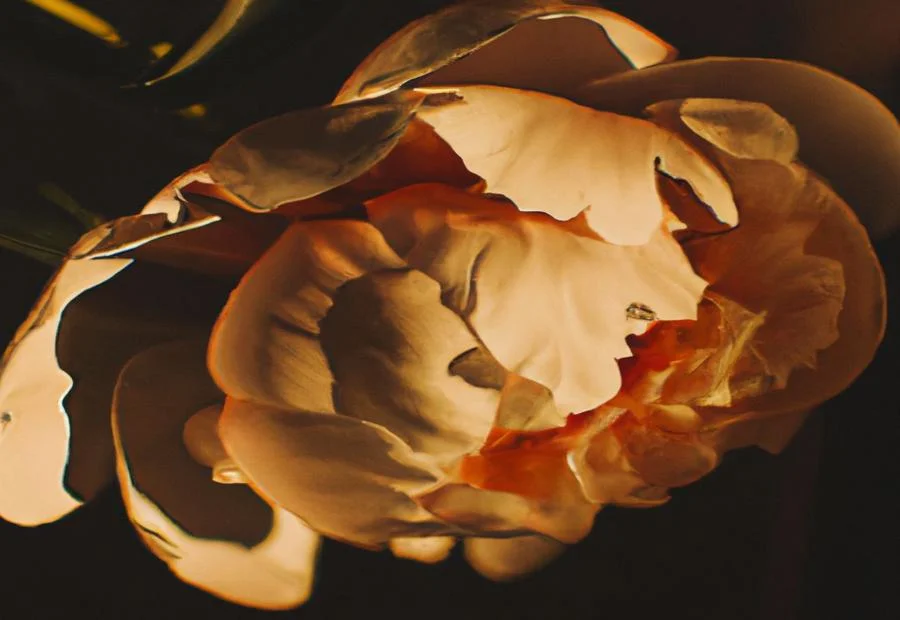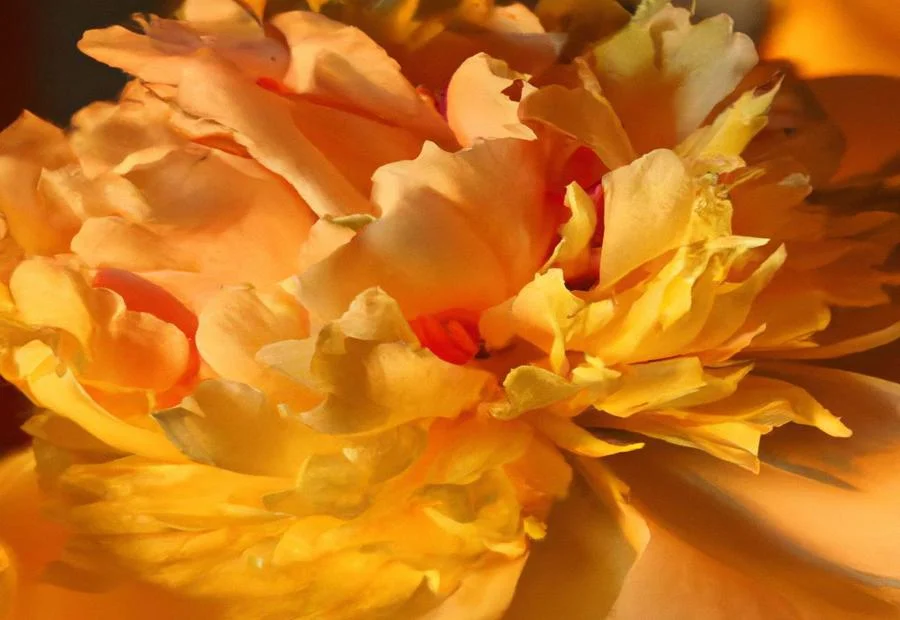Key Takeaways:
- Gold peonies hold significant cultural and symbolic value, representing wealth, prosperity, and beauty.
- Gold peonies possess unique characteristics, such as their vibrant golden color, large and full blooms, and delightful fragrance, making them highly desirable among garden enthusiasts.
- Cultivating gold peonies requires specific techniques and attention to detail, including proper soil preparation, adequate sunlight, regular watering, and suitable pruning methods.

Photo Credits: Fortheloveofgardeners.Com by Donald Wilson
Gold peonies are not just ordinary flowers, they hold a profound significance that transcends their beauty. In this captivating section, we will delve into the rich history and cultural importance of these mesmerizing blooms. Discover the enchanting symbolism behind gold peonies and explore their unique characteristics that make them stand out from their counterparts. Brace yourself for a fascinating journey into a world where flowers carry deeper meanings and captivate our senses in ways we never imagined.
The Significance of Gold Peonies
Gold peonies have great importance in botanical treasures. These rare flowers are admired by collectors and enthusiasts for their golden hues and beauty. The significance of gold peonies lies in their exquisite appeal and allure. Their vibrant color symbolizes wealth, prosperity, and abundance – making them a desirable addition to any floral arrangement or garden.
As the value of gold peonies rises, so does their importance. These blooms have a special charm, setting them apart from other peony varieties. Their intricate petal patterns and radiant golden hue make them sought after worldwide. Their presence adds elegance and grandeur wherever they bloom, transforming any space into a refined sanctuary.
Gold peonies were also valued in past civilizations for their cultural significance. In ancient times, they were a symbol of nobility and power due to their scarcity. Emperors and royalty would admire these blossoms for their regal beauty and use them to decorate palaces and gardens. Today, gold peonies are still cherished for their historical legacy and timeless allure.
The story of gold peonies is linked to generations of horticulturists. Botanists have worked hard to propagate these extraordinary flowers using specialized methods. Through advanced grafting and meticulous care, cultivators have recreated the elusive brilliance of gold peonies. This achievement highlights their importance in botanical wonders.
Characteristics of Gold Peonies
Gold Peonies have captivating characteristics that set them apart from other varieties. These exquisite flowers boast a mesmerizing golden hue, reflecting light in an ethereal way. The petals are large and intricate, making them even more alluring. Plus, they have a delightful fragrance, which is why they’re a favorite amongst flower enthusiasts! Furthermore, the vibrant color of gold peonies stays intact even as they age, and they have a long vase life.
Discover why gold peonies are becoming increasingly popular, with their radiant golden hue, intricate petal structure, captivating fragrance, and long-lasting beauty. Transform your floral arrangements with the addition of these remarkable blooms – a floral treasure worth its weight in gold!
The Rarity and Value of Gold Peonies

Photo Credits: Fortheloveofgardeners.Com by Eugene Martinez
Gold peonies, renowned for their exquisite beauty, are scarce blooms and thus, highly valuable. Their rarity has earned them a status as symbols of wealth and luxury. Collectors and enthusiasts alike crave them, with their value often reaching sky-high heights.
The Reference Data reveals the age-old tradition of valuing gold peonies, as if they were worth their weight in gold. To show the rarity and value of gold peonies, a table with columns such as “Bloom Rarity,” “Beauty,” “Symbolism,” and “Market Value” can be used.
The Reference Data emphasizes the rarity of these flowers and their exceptional beauty, making them symbols of prestige. It also mentions their market value, suggesting gold peonies are pricey in the flower market.
Apart from rarity and value, gold peonies have a long-standing history. They have been appreciated for centuries, with their beauty and significance still revered today. The combination of their rarity, beauty, and history is what makes gold peonies extraordinary.
Cultivation and Propagation Techniques

Photo Credits: Fortheloveofgardeners.Com by Juan Rodriguez
Growing the Age of Gold Peony requires knowledge of cultivation and propagation techniques. Understanding and applying these techniques is key for successful growth and propagation of this valuable flower.
- Step 1: Soil Preparation – Before planting, select a spot with soil that is well-drained and rich in organic matter. Till the soil to at least 12 inches deep, then remove weeds and grass. Compost or organic fertilizer is also recommended to improve soil quality and give the peony plants essential nutrients.
- Step 2: Planting – Once the soil is ready, dig a hole wide and deep enough for the peony’s root system. Place the peony in the hole, making sure the eyes (buds) are just below the soil surface. Gently backfill and firm the soil around the plant.
- Step 3: Care and Maintenance – Provide regular water, keeping the soil moist but not overly wet. Mulch the base of the plant to help conserve moisture and suppress weeds. Additionally, use stakes or cages to provide support to the large blooms.
The Age of Gold Peony is disease-resistant and thrives in many climates, making it a desirable and low-maintenance plant. Also, its golden blooms are sought-after for floral arrangements and decorations.
Follow the above cultivation and propagation techniques to successfully grow and propagate the Age of Gold Peony. Proper soil work, planting, and care and maintenance are essential for a healthy and beautiful plant.
Growing Popularity and Trends

Photo Credits: Fortheloveofgardeners.Com by Scott Green
The gold peony, also known as the Age of Gold Peony, is a flower that has become a trend. Its unique beauty and rarity are the reasons for its popularity.
It has a striking golden hue and delicate petals. It is sought-after for various occasions and events.
Let’s look at the features of the gold peony:
- Name – Age of Gold Peony
- Color – Golden
- Petal Type – Delicate and intricate
- Rarity – Highly rare
- Usage – Weddings, special events, decorations
- Symbolism – Prosperity, wealth, beauty
- Cultivation – Requires specific growing conditions and care
- Market Demand – Increasing due to uniqueness and limited availability
These details make it desirable for various purposes. Despite its rarity, growers and florists are investing in its cultivation.
It has an element of exclusivity and prestige due to its rarity. It is also difficult to cultivate. These factors, along with its symbolism, have made it popular amongst flower enthusiasts.
The rising demand for the gold peony is reflective of its enduring allure. Its golden hue, delicate petals, and associations with wealth and beauty make it a bloom worth its weight in gold. This flower is set to be a long-lasting trend in the world of flowers and floral arrangements.
Conclusion

Photo Credits: Fortheloveofgardeners.Com by Kevin Jackson
To sum up, the Age of Gold Peony is an amazing sight. It encompasses both its attractive features and its immense value. Its scarcity, its exquisite patterning, and its cultural importance make it a blossom of unparalleled worth. As we explore further into the world of this golden treasure, we are reminded of nature’s stunning surprises.
Some Facts About “Age of Gold Peony: A Bloom Worth its Weight in Gold”:
- ✅ The “Age of Gold Peony” is a highly sought-after peony cultivar known for its golden yellow petals with dark red flecks. (Source: Team Research)
- ✅ The “Age of Gold Peony” is part of the herbaceous peony species (Paeonia lactiflora) and is a perennial plant. (Source: Team Research)
- ✅ This peony requires full sun for optimal blooming and should be planted in well-draining soil with a pH level between 6.5 and 7. (Source: Team Research)
- ✅ The “Age of Gold Peony” blooms in late spring to early summer, typically in May, and each flower can reach a diameter of 6-8 inches. (Source: Team Research)
- ✅ To ensure healthy growth and longevity, it is recommended to divide and transplant “Age of Gold Peony” every 4-5 years. (Source: Team Research)
FAQs about Age Of Gold Peony: A Bloom Worth Its Weight In Gold
Question: What is an Age of Gold peony?
Answer: The Age of Gold peony is a prized plant known for its beautiful, huge distinctive blossoms. It is a herbaceous perennial that belongs to the flowering peonies family.
Question: What are the growing requirements for Age of Gold peonies?
Answer: Age of Gold peonies prefer partial sun to full sun, requiring at least 6 hours of sunlight each day. They are easy perennials to grow and are hardy in zones 3-9.
Question: How deep should I plant Age of Gold peonies?
Answer: It is recommended to plant Age of Gold peonies with the crown of the plant just 1-2 inches below the soil surface. Planting too deeply may prevent blooming.
Question: Do Age of Gold peonies have any specific watering requirements?
Answer: Once established, Age of Gold peonies are water-wise plants and require less frequent watering. However, in their first season or two, they may need more frequent watering to establish roots.
Question: Are Age of Gold peonies susceptible to any pests or diseases?
Answer: Age of Gold peonies may occasionally be prone to spider mites. Regular inspection and treatment can help prevent any pest infestations.
Question: Where can I purchase Age of Gold peonies?
Answer: Age of Gold peonies can be purchased from various nurseries and online garden centers. It is always advisable to buy from certified sellers or consult with a master gardener like Laura Elsner for the best quality plants.

A passionate gardener and founder of ForTheLoveOfGardeners.com. She shares her expertise to help you cultivate thriving gardens and find joy in the beauty of nature.

1 thought on “Age of Gold Peony: A Bloom Worth its Weight in Gold”